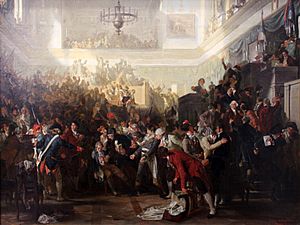Fall of Maximilien Robespierre facts for kids
Quick facts for kids Coup of 9–10 Thermidor |
|||||||
|---|---|---|---|---|---|---|---|
| Part of the French Revolution | |||||||
 Fall of Robespierre in the Convention by Max Adamo |
|||||||
|
|||||||
| Belligerents | |||||||
|
|
|
||||||
| Commanders and leaders | |||||||
|
|
||||||
| Strength | |||||||
| Unknown | c. 3,000 loyalists | ||||||
| Casualties and losses | |||||||
| Unknown |
Various people were executed:
|
||||||
The Coup of 9–10 Thermidor was a major event during the French Revolution. It marked the end of the Reign of Terror. This coup led to the fall of Maximilien Robespierre, a powerful leader. It happened in Paris, France, in July 1794.
How Robespierre Fell
The events began on 8 Thermidor Year II. This was July 26, 1794, on our calendar. Robespierre gave a speech to the National Convention, which was France's government. In his speech, he talked about hidden enemies and plotters. He said these people were inside the government itself.
The Fear in the Convention
Robespierre refused to name these "enemies." This made many members of the Convention very worried. They feared he was planning to remove them from power. This created a lot of tension and fear among the deputies.
The Arrest and Execution
The very next day, on 9 Thermidor (July 27, 1794), things changed. A man named Jean-Lambert Tallien spoke out against Robespierre. Tallien was one of the people Robespierre had in mind as a plotter. The Convention then voted to arrest Robespierre.
By the end of the next day, 10 Thermidor (July 28, 1794), Robespierre was executed. He was taken to the Place de la Revolution in Paris. This was the same place where King Louis XVI had been executed. Robespierre was executed by guillotine, a machine used for beheadings. Many of his supporters were also executed.
See also
 In Spanish: Caída de Robespierre para niños
In Spanish: Caída de Robespierre para niños

